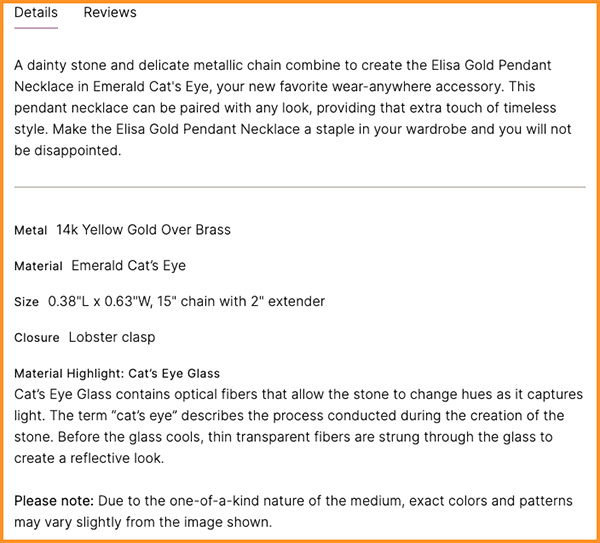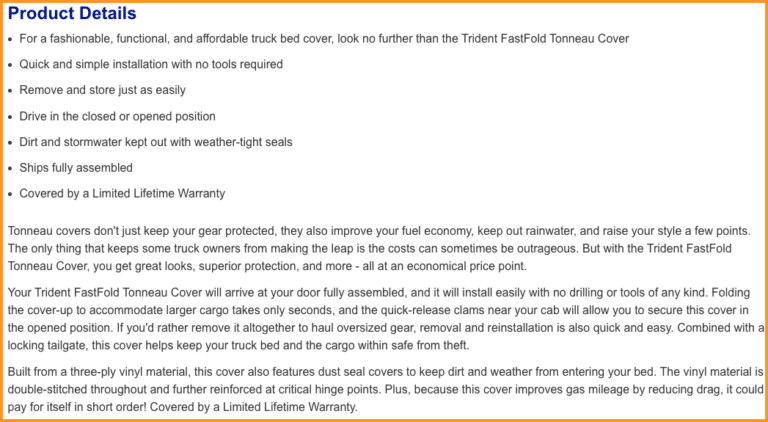Economic shifts, weather, cultural events, and more can influence brand demand, and many of these factors feel out of your control in marketing. You know what’s IN your control? Your investment in non-branded keywords.
Increase traffic and conversions with our top tips for creating product descriptions.
You’re happily shopping online and click through to a product page — only to come face-to-face with thin or missing content. How do you learn details about the product and make sure it’s actually what you’re looking for?
You hate this experience, and so do your customers. Don’t be another brand that disappoints people with generic or non-existent product content. Learn how to write winning product descriptions with this guide.
Influence Purchasing Decisions
Shopping online means a consumer can’t physically see or feel your products. You need to give them all the information they need to confidently make a purchase. Your product descriptions can make or break their decision to buy.
Help Products Be Found Online (and Not Returned!)
When done correctly, product descriptions can help your product get found on search, increase conversion rates, decrease abandoned car rates, and reduce returns.
85% of shoppers surveyed say product information and pictures are important when deciding which brand or retailer to buy from. (Think with Google)
Product descriptions need to be informative, engaging, and SEO-friendly. Here are our top tips for creating product descriptions that boost conversions:
Duplicate content doesn’t fly for blogs, and it won’t work for product descriptions, either. You can’t copy-paste the same generic content across multiple products and expect it to perform well. Every SKU needs a unique description to avoid dings from the Google algorithm.
Writing all those product descriptions can sound daunting if you have hundreds or thousands of SKUs. Instead of straining internal resources, reach out to a company that can quickly create product descriptions at scale — like GPO!
One of our e-commerce clients saw a 17% increase in cart conversions after creating 16,000 unique product descriptions in 6 months.
Before writing your description, you need to know the product’s target audience. Understanding your ideal buyer will help you identify what type of content will resonate with them. Determine their pain points, questions they might have, what they hope to get out of the product, the appropriate language, etc. Explicitly state how your product solves their problem, or how it fits into the reader’s life.
Let’s say you’re writing a description for an auto parts retailer. Your ideal buyer is likely a DIYer who cares about saving money and getting the job done correctly. Your product description should be straightforward and reassure the shopper that the part will fit their specific vehicle without negatively impacting its performance.
A Baymard study found that “10% of the largest e-commerce sites fail to have a consistently high level of detail for their product descriptions,” often leading to product abandonment. Include plenty of detail in your product descriptions so customers fully understand what they’re buying.
Key information to include:
The following product description from Kendra Scott provides plenty of detail. The user can easily find the color, material, pendant size, chain length, and closure style. Kendra Scott also notes that the colors and patterns may vary, helping set the right expectations to avoid customer disappointment.

If you want users to find your products on search, you need to perform SEO keyphrase research and include relevant keyphrases in your content.
We don’t mean going after short-tail keyphrases like “dresses.” While this keyphrase might have a monthly search volume of 301k (according to Semrush), it also has a very high keyphrase difficulty (80%). Not only will you struggle to rank well for it, but the broader the keyphrase, the harder it is to know search intent. Someone searching for “dresses” is likely casually browsing or just beginning their search to compare brands, styles, and colors.
A more specific long-tail keyphrase like “sage green dress” has a lower search volume (27.1k) but also a lower keyphrase difficulty (17%). A consumer searching for this phrase is probably further along in the buyer’s journey and more likely to complete a purchase.
Once you pick your keyphrases, you need to incorporate them naturally throughout your description. Product descriptions are often shorter than other pieces of SEO content, so you really need to watch your keyphrase density here. Ideally, you will only use each keyphrase a couple of times max.
Take this dress description from ModCloth as an example.

We can guess the writer is targeting the keyphrases “bias-cut midi dress,” “minimalist midi dress,” and “bias-cut dress.” Each of these keyphrases is only incorporated once and used in a very natural-sounding way.
Yes, features are important, but remember the benefits those features offer. While the features can provide the nitty-gritty details, the buyer usually cares more about what those details can do for them.
Let’s look at this description from Nespresso for one of their coffee machines.

“Adjustable water tank position” as a stand-alone feature might not mean much to the consumer. But “to optimize kitchen countertop space” could be a pivotal selling point for someone with a smaller kitchen.
How long should a product description be? It should be long enough to convey all the necessary information but not so long that the user’s eyes glaze over. You want to stick to around 300 words or less in most cases.
Even when keeping it short, you want your product description to be scannable. You can accomplish this by using bullet points. Your entire description can be broken out into bullet points like the Nespresso example we reviewed earlier. You can also use bullet points to highlight crucial information or summarize a longer description.
Here’s a great example from Napa. They use bullet points to call out a few key features and benefits of the tonneau cover while providing more detail in the following paragraphs.

You’ll adjust the tone of voice depending on the target audience, but every description should be conversational. Think of how you would talk to a customer standing right in front of you, and let that influence how you write your description. Use simple language, keep sentences short, and address the reader as “you.” Help the customer imagine the product in their life!
Now, to balance telling with showing! Since potential customers can’t see and touch products in person, they rely heavily on product photos. In fact, 56% of users immediately browse product images after landing on a product page. Make sure your written product description is accompanied by high-quality images that clearly show the product from different angles. Don’t forget to include detailed, optimized alt text for each image!
Whether you have a few handfuls of or a few thousand product descriptions, writing them all can feel like running a marathon after years as a couch potato. With GPO on your side, the impossible becomes possible. Our team can quickly create high-quality, unique product descriptions that attract and convert customers. Get in touch today.

Economic shifts, weather, cultural events, and more can influence brand demand, and many of these factors feel out of your control in marketing. You know what’s IN your control? Your investment in non-branded keywords.

Learn how a brain-based behavioral health center is expanding its local reach online to increase patient consultations despite a limited physical footprint.

Your seasonal content is looking a little dusty. Is it time for a quick refresh, or do you need to start from scratch?
